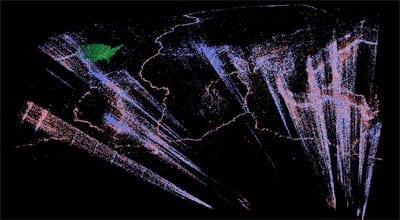
Making sense of the ever-increasing mounds of data is one of the great challenges facing researchers today.
At Missouri University of Science and Technology, staff and students in the information technology department have come up with an approach to help researchers gain a new perspective on their data.
The IT research support services(RSS) team at Missouri S&T has developed a tool to help researchers visualize their data. Called Visualizing Four Dimensions in Rolla, the system allows researchers to view their data in 3-D over various time spans.
The system is called V4DiR for short and is pronounced “Vader,” as in Darth. It holds promise for shedding light on various research projects at Missouri S&T and elsewhere, says RSS director Mark Bookout.
On campus, Bookout’s team has been demonstrating V4DiR’s power to researchers by showing maps-in-motion of natural disasters: all of the world’s earthquake occurrences from 1920 through 2012 as well as tornado activity in the U.S. since 1950. The earthquake data is also being used by Dr. Stephen Gao, a professor of geology and geophysics who is studying seismic activity in the Horn of Africa region.
The team also demonstrates V4DiR with a 3-D immersion of a New Mexico mine created by a remote-sensing technology known as LIDAR. With V4DiR it is possible to take a virtual walk-through of the mine, scanning the environment for anything that a researcher is looking for or that may seem out of place.
The RSS team uses projectors, head-mounted displays and a big-screen 3D TV to show off V4DiR’s capabilities. That on-screen visualization – a continuous loop of information – can be manipulated to help researchers home in on specific data points. For instance, the visualization can be tilted on an axis to provide greater levels of depth or various angles. It can also be stopped if researchers want to examine data from a particular time frame.
“We can pinpoint exactly where on the earth, as well as how deep within the earth, an earthquake has happened,” says Nick Eggleston, a junior computer science major from Maysville, Mo., who leads the project. Eggleston is part of a cadre of undergraduate students employed by RSS to develop tools that support Missouri S&T’s computing-intensive research efforts. He is developing a computer program to allow the software to show how data progresses over time. The program will also allow users to manipulate the format of their data and combine similar sets of data.
As impressive as the technology is in its ability to make images out of numbers, another aspect of V4DiR may be even more remarkable, says RSS director Bookout.
“One of the most powerful things to me is to watch how someone who sees it for the first time reacts to the visualization,” Bookout says. “Without exception, the first experience for faculty who see what we can do translates into a ‘Can it do this?’ conversation. Sometimes we hear, ‘I’ve never seen that before’ or even, ‘Uh-oh, what I thought was happening here in the data was wrong. I need to change something.’”
The Latest Bing News on:
Visualizing Four Dimensions
- Visual Analytics Market Soars: Anticipated CAGR of 21.4% to Achieve US$ 58,969.8 Million by 2033on May 7, 2024 at 10:18 pm
The visual analytics market is undergoing a significant transformation, with a remarkable annual growth rate of 21.4%. This impressive journey is projected to lead to a market size of an ...
- Ask the Builder: Have fun with exterior tile or natural stoneon May 6, 2024 at 2:00 pm
I just returned from an eight-day trip to southern California. The purpose was to visit my youngest daughter and several dear friends. The weather was excellent, and although I knew about the June ...
- The Learning Networkon May 6, 2024 at 12:46 am
Look closely at this image, stripped of its caption, and join the moderated conversation about what you and other students see. By The Learning Network New federal rules will require school ...
- Purdue Computeson May 5, 2024 at 11:22 pm
As student interest in computing-related majors and the societal impact of artificial intelligence and chips continue to rise rapidly, Purdue has launched a new major initiative, Purdue Computes, ...
- Visualizing A Black Hole’s Flares In 3Don April 26, 2024 at 11:49 am
Researchers are trying to develop a better picture of what’s happening in the regions closest to a black hole’s event horizon.
- The Top Four Benefits of Visualizing Construction Dataon April 25, 2024 at 5:00 pm
Visualizing construction data is a constantly evolving practice, one that probably began with physical pins on a site map and has grown into the use of configurable, digital maps with real-time ...
- New technique lets scientists create resistance-free electron channelson April 8, 2024 at 5:00 pm
Researchers are working to understand better the properties of chiral interface states in real materials, but visualizing their ... without resistance at one-dimensional "edges"—the physical ...
- Geographically Visualizing Customer Data with Blazor and ArcGISon March 4, 2024 at 4:00 pm
Developers, always seeking new techniques to enhance their applications and provide meaningful insights to users, might want to consider the power of geographically visualizing data ... projection of ...
- How to Change the Aspect Ratio in Midjourneyon January 2, 2024 at 4:05 pm
Use this guide to break out of the default 1:1 square image dimensions. The Aspect Ratio Parameter in Midjourney ... Another alternative is --ar 4:5, which has a shorter vertical height but is a ...
- How to Become a Fashion Designeron July 26, 2021 at 2:45 am
The U.S. Bureau of Labor Statistics predicts that there will be 4% fewer fashion design jobs ... you an advantage when you're designing and visualizing fabric properties, silhouette, drape ...
The Latest Google Headlines on:
Visualizing Four Dimensions
[google_news title=”” keyword=”Visualizing Four Dimensions” num_posts=”10″ blurb_length=”0″ show_thumb=”left”]
The Latest Bing News on:
Visualization of data
- Bionano stock climbs 7% in wake of Q1 report, software upgradeson May 9, 2024 at 11:50 am
Shares of Bionano Genomics (NASDAQ:BNGO) rose 7% Thursday in the wake of a better-than-expected Q1 earnings report and news that it has upgraded its computational tools for cancer analysis. The ...
- Bionano Announces Series of Major Advancements to its Suite of Computational Tools for Comprehensive Cancer Analysison May 9, 2024 at 7:00 am
Bionano Genomics, Inc. (Nasdaq: BNGO) today announced significant upgrades to its suite of computational tools for comprehensive cancer analysis. These advancements to the company’s VIA™ software ...
- Saudi Arabia Photonic Sensor Market Power of Data Visualization Techniques for Communicating Research Findingson May 9, 2024 at 12:14 am
report_id=SA1361 The report covers market definition, regional market opportunities, sales and revenue by region, manufacturing cost analysis, Industrial Chain analysis, market effect factors analysis ...
- Plunge into a Black Hole with NASA's new immersive visualization (w/video)on May 8, 2024 at 5:00 pm
To create the visualizations, Schnittman teamed up with fellow Goddard scientist Brian Powell and used the Discover supercomputer at the NASA Center for Climate Simulation. The project generated about ...
- Electricity Maps calculates the carbon intensity of electricity consumption to optimize usage at scaleon May 8, 2024 at 11:03 am
If you’re an electricity nerd, chances are you’ve already spent quite a few hours looking at Electricity Maps and its mesmerizing export flow animations.
- Visual Analytics Market Soars: Anticipated CAGR of 21.4% to Achieve US$ 58,969.8 Million by 2033on May 7, 2024 at 10:18 pm
The visual analytics market is undergoing a significant transformation, with a remarkable annual growth rate of 21.4%. This impressive journey is projected to lead to a market size of an ...
- New black hole visualization takes viewers beyond the brinkon May 6, 2024 at 12:21 pm
Ever wonder what happens when you fall into a black hole? Now, thanks to a new, immersive visualization produced on a NASA supercomputer, viewers can plunge into the event horizon, a black hole's ...
- Softlist.io: Pioneering Better Decision-Making in Data Visualization for Businesseson May 5, 2024 at 10:43 pm
Softlist.io helps marketers choose the best software for their needs by giving them thorough reviews and data visualization tools. Softlist.io ...
- Biological Data Visualization Market Big Growth Predicted for Market Size in the Futureon May 5, 2024 at 2:42 pm
Biological Data Visualization Market is valued approximately at USD 741.9 million in 2019 and is anticipated to grow with a healthy growth rate of more than 9.6% over the forecast period 2020-2027.
- Study finds AI tool opens data visualization to more studentson April 29, 2024 at 2:34 pm
A new study from the Tepper School of Business at Carnegie Mellon University published in the Journal of Business and Technical Communication shows that ChatGPT can help students create effective ...
The Latest Google Headlines on:
Visualization of data
[google_news title=”” keyword=”visualization of data” num_posts=”10″ blurb_length=”0″ show_thumb=”left”]









